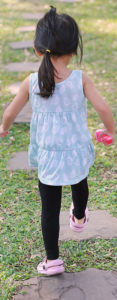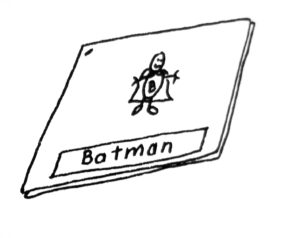Following is a very brief overview of the strategies at the heart of Kids Write To Read. If you decide to experiment with them, please also read the page describing the how and why of a A “Natural” Approach. Then for greater detail, you’ll find links to various critical topics summarized on the Welcome Page of this website. This information will not only help you carry out these strategies effectively, but explain to others what you are doing and why.
What a child is doing — in the beginning

Each child asks for a word with special meaning for them. This becomes their Key Word.
As someone writes (on sturdy card stock) the word they have asked for, the child watches and listens for the name and/or sound of each letter.
Then they trace over every letter in the word with the index finger of their writing hand.
Next, they punch a hole in the word card and place it on a metal word ring. If they easily recognize it the following session, it stays on their ring. Once familiar with this process, a child seldom “forgets” yesterday’s word. (But no hints are given., and it’s extremely important that a word they don’t immediately recognize comes off their word ring. For when gathered correctly, their word ring easily becomes a collection of words that give them confidence with print.)
So eventually they have a sizeable collection of words they can quickly “read” through at the beginning of each session. (Later on, the child will use these old words on their ring as a resource for spelling.)
They also receive a duplicate of their word, written on newsprint. They glue the duplicate into their writing book and make a picture about it. With that, they have completed the follow-up activity known as Step 1:
The Path the child is taking — over time
 Each session, the child asks for a new word, and as their understanding and skills grow — over time and at their own pace — they move through a series of 6 increasingly complex follow-up activities. These are referred to as The Steps. You will find detailed directions for giving words at each step here.
Each session, the child asks for a new word, and as their understanding and skills grow — over time and at their own pace — they move through a series of 6 increasingly complex follow-up activities. These are referred to as The Steps. You will find detailed directions for giving words at each step here.
By the time they have reached Step 6, the child has developed a firm grasp of phonics –through the need to spell.
They have also begun to notice they can recognize words in books and sound them out, if need be. So reading has spontaneously emerged through their repeated experience with the writing process, and they move effortlessly into reading professionally published books for enjoyment and information.
Following is an overview of what a child is doing at each of the 6 Steps along the way in Kids Write To Read:
Criteria Make the Steps a fail-safe process
The teacher uses a clear set of criteria to decide when a child is ready to move from one Step to the next. So the process is fail-safe. They may take weeks, months, even years, but every child who can speak, eventually learns to read and write fluently — without struggle or failure.
With fear of failure not an issue, and being allowed to work with ideas that capture their interest and imagination, the children carry out a process that mirrors how they learned to speak. And they enjoy and take pride in it in much the same way. (See the subheading, Helping the Child Learn to Read, at the top of the page, Key Words & The Steps.)
More Information
Please be sure to read the page, Basics for Parents & Teachers. It has links to summaries of the basic components of this approach, beginning with how and why it follows the child’s natural development.
For that same purpose, I have also compared this approach with more traditional approaches, and you will find that comparison under the sub-heading, First Consider: Are We Teaching Reading or Are We Helping the Child learn to Read? at the top of the page, Key Words and The Steps.
next —> How A Natural Approach Was Developed
< — Back About The Author
individualized language experience, language experience, LEA, write to read, language experience activities, language experience strategies, The Steps, Key Words, Key Words and The Steps,
phonics, overview of what the child is doing, firm grasp of phonics, reading professionally published books, fail-safe, path toward literacy, Janet Kierstead, Janet Kierstead, Ph.D., Dr. Janet Kierstead

